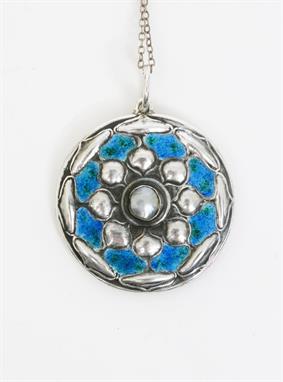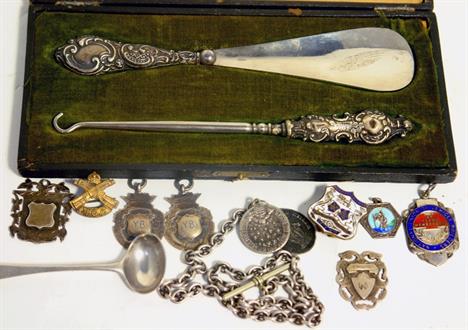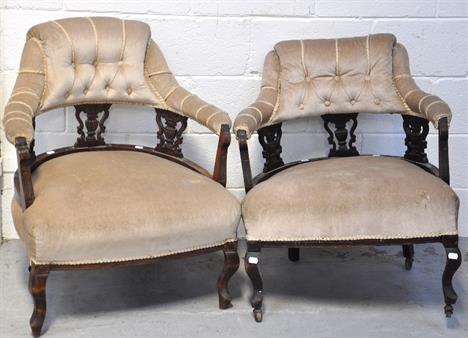We found 110986 price guide item(s) matching your search
There are 110986 lots that match your search criteria. Subscribe now to get instant access to the full price guide service.
Click here to subscribe- List
- Grid
-
110986 item(s)/page
Anglo-Saxon Gilt-Bronze Button Brooch6th century AD. A discoid plate brooch with flared rim, two concentric inner borders and central helmetted face motif; remains of catchplate and pin-lug to the reverse; Avent & Evison`s Class Ei. Cf. Avent, R. & Evison, V.I. Anglo-Saxon Button Brooches in Archaeologia, vol.CVII, 1982, item 22.6. Portable Antiquities Scheme reference: IOW-C2D00D, a copy of which is included in the sale. 2.68 grams, 16mm (3/4"). Found Isle of Wight, Hampshire, UK. Fine condition.
Anglo-Saxon Gilt-Bronze Helmetted Head Button Brooch6th-7th century AD. A gilt button brooch of Class Bi with heavy gilding to the upper face, male helmetted mask within a circular frame, band of pellets around the face and a second band to the outer border; flared rim, catchplate to the reverse. Cf. Avent, R. & Evison, V.I. Anglo-Saxon Button Brooches in Archaelogia, vol.CVII, 1982, item 2.3. 2.09 grams, 17mm. (3/4"). Found Bournemouth, Dorset, UK. Very fine condition. Rare with second pelletted band.
A rare composition musical automaton figure, attributed to Gustave Vichy, Paris A rare composition musical automaton figure, attributed to Gustave Vichy, Paris, circa 1900 , modelled as an African American banjo player wearing a red cap and shirt, blue coat and striped pantaloons seated on an oversized gilt stool upholstered in red velvet with tassel border over conforming green and gold velvet pendant panels enclosing the musical and automaton drive mechanisms, once activated (via a brass pull button to the rear of the stool) the figure strums the banjo with his right hand whilst rotating and nodding his head, blinking his glass eyes and swinging his right leg, (restored), 61cm (24ins) high. Gustave Vichy was the son of Parisian watch and clockmaker Antoine Vichy who established a workshop making clocks, mechanical objects and toys in 1862. Unfortunately shortly after the founding of the business Antoine died leaving the firm in the hands of his widow Genevieve. By 1865 the business had become bankrupt and was wound up only to be re-established in by their son, Gustave, this time specialising in automata. Gustave Vichy was well placed to respond to the Parisian fashion for automata and mecahnical items of a `mysterious` nature which reached its height during the latter years of the 19th century. The Vichy workshop became leaders in the field and were particularly well known for the realism and inventive nature of their figures. In 1893 Gustave handed the day to day direction of the firm over to his son, Henry, who introduced further innovations such as the Lioret gramophone which for the first time enabled the figures to speak. In 1904 Gustave Vichy died leaving the business to be passed on to his former factory foreman Auguste Triboulet who continued in the Vichy tradition until his death in 1920 when the firm was sold to the French toy manufacturers J.A.F. The current lot can be attributed to Gustave Vichy on the basis that the design appears in his 1900 catalogue captioned Petit negre jouant du banjo.
A William IV mahogany breakfront bookcase, circa 1835 A William IV mahogany breakfront bookcase , circa 1835, the moulded cornice above four glass panelled doors opening to adjustable shelves nd flanked by carved foliate terminals, the lower section with four frieze drawers operated by concealed button release, above arch panelled doors flanked by turned and acanthus carved pilasters, on a plinth base, 262cm high, 257cm wide, 42cm deep
Eight silver topped faceted glass toilet bottles and jars, London 1929 and plated wares, comprising; a pair of Victorian fish servers, with ivory handles, cased, a set of six tea knives, cased, two part sets of dessert or fruit knives and forks, having mother of pearl handles, a Foreign spoon and a button hook.
Silver and silver mounted wares, comprising; a circular capstan shaped inkwell, Birmingham 1934, loaded, a square dish, mounted with a Greek medallion, detailed 900, a circular Armada style dish, London 1971, a rectangular matchbox slide, presentation inscribed, Birmingham 1918 and a small button hook, Birmingham 1906.
A rectangular hinge lidded snuff box, probably Dutch 19th century, two further boxes, a pair of mother of pearl folding lorgnettes, a silver bladed mother of pearl folding fruit knife, Birmingham 1846, a silver handled button hook, London 1909, a rectangular photograph frame, a circular base metal dish, decorated with the Art Nouveau portrait of a lady and five further items.
A violin, interior paper label reads 'Petrus Guarnerius Filius and Fecit Mantua Anno 1757', back measures fourteen inches minus button, with bow and hard case, together with another violin, interior paper label reads 'A Egidius Kloz in Mittenwald an der Ifor 1706', the back measures 13 3/4" minus button, with two bows and a walnut case (2).
A violin, interior paper label reads 'Petrus Guarnerius Filius and Fecit Mantua Anno 1757', back measures fourteen inches minus button, with bow and hard case, together with another violin, interior paper label reads 'A Egidius Kloz in Mittenwald an der Ifor 1706', the back measures 13 3/4" minus button, with two bows and a walnut case (2).
A George III silver cream jug of cushion form with gadrooned rim, on ball feet, London 1812, a silver vesta case with engraved foliate decoration, Birmingham 1902, a silver cigarette box, Birmingham 1911, two silver handled button hooks, together with a collection of silver items, including three pairs of sugar tongs.
Eight silver topped faceted glass toilet bottles and jars, London 1929 and plated wares, comprising; a pair of Victorian fish servers, with ivory handles, cased, a set of six tea knives, cased, two part sets of dessert or fruit knives and forks, having mother of pearl handles, a Foreign spoon and a button hook.
Silver and silver mounted wares, comprising; a circular capstan shaped inkwell, Birmingham 1934, loaded, a square dish, mounted with a Greek medallion, detailed 900, a circular Armada style dish, London 1971, a rectangular matchbox slide, presentation inscribed, Birmingham 1918 and a small button hook, Birmingham 1906.
A rectangular hinge lidded snuff box, probably Dutch 19th century, two further boxes, a pair of mother of pearl folding lorgnettes, a silver bladed mother of pearl folding fruit knife, Birmingham 1846, a silver handled button hook, London 1909, a rectangular photograph frame, a circular base metal dish, decorated with the Art Nouveau portrait of a lady and five further items.
A rare composition musical automaton figure, attributed to Gustave Vichy, Paris A rare composition musical automaton figure, attributed to Gustave Vichy, Paris, circa 1900 , modelled as an African American banjo player wearing a red cap and shirt, blue coat and striped pantaloons seated on an oversized gilt stool upholstered in red velvet with tassel border over conforming green and gold velvet pendant panels enclosing the musical and automaton drive mechanisms, once activated (via a brass pull button to the rear of the stool) the figure strums the banjo with his right hand whilst rotating and nodding his head, blinking his glass eyes and swinging his right leg, (restored), 61cm (24ins) high. Gustave Vichy was the son of Parisian watch and clockmaker Antoine Vichy who established a workshop making clocks, mechanical objects and toys in 1862. Unfortunately shortly after the founding of the business Antoine died leaving the firm in the hands of his widow Genevieve. By 1865 the business had become bankrupt and was wound up only to be re-established in by their son, Gustave, this time specialising in automata. Gustave Vichy was well placed to respond to the Parisian fashion for automata and mecahnical items of a `mysterious` nature which reached its height during the latter years of the 19th century. The Vichy workshop became leaders in the field and were particularly well known for the realism and inventive nature of their figures. In 1893 Gustave handed the day to day direction of the firm over to his son, Henry, who introduced further innovations such as the Lioret gramophone which for the first time enabled the figures to speak. In 1904 Gustave Vichy died leaving the business to be passed on to his former factory foreman Auguste Triboulet who continued in the Vichy tradition until his death in 1920 when the firm was sold to the French toy manufacturers J.A.F. The current lot can be attributed to Gustave Vichy on the basis that the design appears in his 1900 catalogue captioned Petit negre jouant du banjo.
A William IV mahogany breakfront bookcase, circa 1835 A William IV mahogany breakfront bookcase , circa 1835, the moulded cornice above four glass panelled doors opening to adjustable shelves nd flanked by carved foliate terminals, the lower section with four frieze drawers operated by concealed button release, above arch panelled doors flanked by turned and acanthus carved pilasters, on a plinth base, 262cm high, 257cm wide, 42cm deep
-
110986 item(s)/page











































